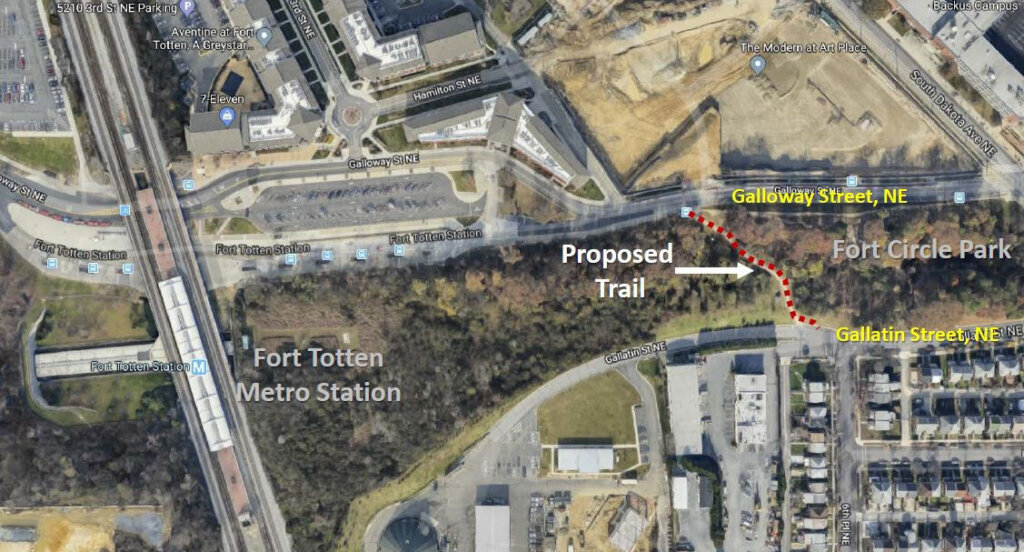A World War I-era unexploded shell discovered in July 2020 by the National Park Service during construction of a trail through Northeast D.C.’s Fort Totten could be a prequel to the decadeslong cleanup of a former World War I chemical weapons site near American University’s campus.
The type of weapon recovered and the history of where it was recovered have suggested a link between the discovery in Ward 5’s Fort Totten and Ward 3’s Spring Valley cleanup at the former American University Experiment Station used by the U.S. government for research and testing of chemical agents, equipment and munitions — once dubbed the “mother of all toxic dumps.”
In response to WTOP’s reporting, D.C. Del. Eleanor Holmes Norton said she will be calling a joint meeting of the park service, the Army Corps of Engineers and Metro to discuss the issue of the chemical weapon and what should be done about it.
“This is about the last thing Ward 5 wanted to hear,” Norton told WTOP. She said she hoped the joint meeting would also include the council members for Ward 3 and Ward 5 as well as the Advisory Neighborhood Commissioners.
After 20 years of Spring Valley cleanup, “For them to discover traces of chemical weapons has got to be very concerning, which is why I believe we need a discussion of these issues immediately, with the appropriate agencies,” she said.
The once-buried 75-millimeter shell was exposed after a period of heavy rain in a section of Fort Totten Park, where the National Park Service was constructing a paved, lit path to replace informal trails through parkland used by Michigan Park residents to reach the Metro.
The path is located east of the Fort Totten Metro station, and west of South Dakota Avenue NE, and bounded on the north and south by Galloway and Gallatin streets.
The National Park Service tells WTOP that after the discovery, it conducted a soil investigation within the area of the proposed trail where the unexploded ordnance was uncovered.
“The investigation showed that the soil sampling results from the Fort Totten trail area are representative of general soil fill conditions in the Fort Totten area and found no evidence of other munitions,” said spokeswoman Cynthia Hernandez.
Army Corps of Engineers: Fort Totten discovery was chemical weapon
A closer look at the empty shell found in Fort Totten — one of seven Northeast D.C. forts used by the Union Army to defend the nation’s capital during the Civil War — revealed it had been modified for use as a chemical weapon.
“When we looked at the X-rays, it was a 75-millimeter ordnance item that we encounter quite a bit at Spring Valley,” said Dan Noble, of the U.S. Army Corps of Engineers, and project manager for the ongoing Spring Valley Formerly Used Defense Site project.
“It had a hex plug burster adapter screwed into the nose of the projectile,” Noble told WTOP. “It would convert what was developed as a conventional munition into a chemical munition.”
The focus of the Spring Valley cleanup was the home at 4825 Glenbrook Road NW, which the Army Corps knocked down in 2012, before painstakingly removing all the soil beneath it.
Work on the Glenbrook Road site included labor-intensive hand-digging and the uncovering of weapons and glassware. Decades after World War I, workers discovered low levels of mustard and lewisite, colorless and odorless compounds, which can cause blistering and lung irritation.
With a 75-milimeter shell adapted as a chemical weapon, “You could fill the munition with a nonexplosive chemical payload, and then the burster is a small amount of explosive, that can be used to open the munition up, and spread the chemical agent around on the ground, when it arrived on target,” Noble said.

Fort Totten’s prequel to Spring Valley cleanup
Even before a contractor digging a utility trench in Spring Valley in 1993 uncovered a buried military ordnance, which prompted the Army Corps of Engineers investigation that revealed homes on Glenbrook Road were built atop chemical weapon burial pits, contaminated soil from Glenbrook Road was trucked to a landscaping project at Fort Totten Metro station.
“What we know is that over at Fort Totten, where the D.C. Metro project was underway, they had a need for soil, and on Glenbrook Road, where they were building the houses, they had excess soil,” Noble said. “We know that an arrangement was made to transfer some soil, from Glenbrook Road, over to Fort Totten.”
In 1992, the heavy equipment operator spreading Glenbrook Road soil at the Fort Totten Metro site felt sickened from the fumes of the soil, and the U.S. Park Service ordered it be removed, Noble told the Spring Valley Restoration Advisory Board. The board holds regular meetings to advise community members on the cleanup.
Where the contaminated Glenbrook Road soil was ultimately sent, after being removed from the Fort Totten Metro site is unknown, according to the U.S. Park Service and the Army Corps.
“Fort Totten is a large space, and the sites you’re referring to are separate areas,” said Hernandez, the Park Service spokeswoman. “The contaminated soil from the Spring Valley cleanup that was placed at Fort Totten and eventually removed by WMATA contractors was not in the trail area, where the unexploded ordnance was found.”
Allen Hengst, who has been blogging about the issue for the last 15 years, said he thinks the contaminated soil was moved from the Fort Totten Metro site a few hundred yards away to the area where the trail is being constructed.
Hengst said he believes the Park Service search after the 2020 discovery was perfunctory, and limited to the immediate trail area in Fort Totten. Hengst suggests a wider search would likely uncover more chemical remnants from the Spring Valley site.
It’s not clear any more physical investigation will be done. The Park Service said it’s currently working with a contractor to redesign a segment of the planned trail to avoid WMATA’s Metrorail infrastructure, and plans to resume trail construction following completion of that design.

“There’s definitely an understanding that this is Park Service property, they’re the responsible federal agency for that property, and they are going to lead the effort, and make the decisions, and take the actions that they think are appropriate,” said Noble, of the Army Corps. “We would just function as the technical resource for them.”
Hernandez, of the Park Service said: “We will continue to look into this issue until we feel we have exhausted information sources, including those of other agencies, such as the U.S. Army Corps of Engineers and (the District’s) Department of Energy and Environment.”
EDITOR’S NOTE: Story has been updated to reflect Allen Hengst is not with the Spring Valley Restoration Advisory Board.








